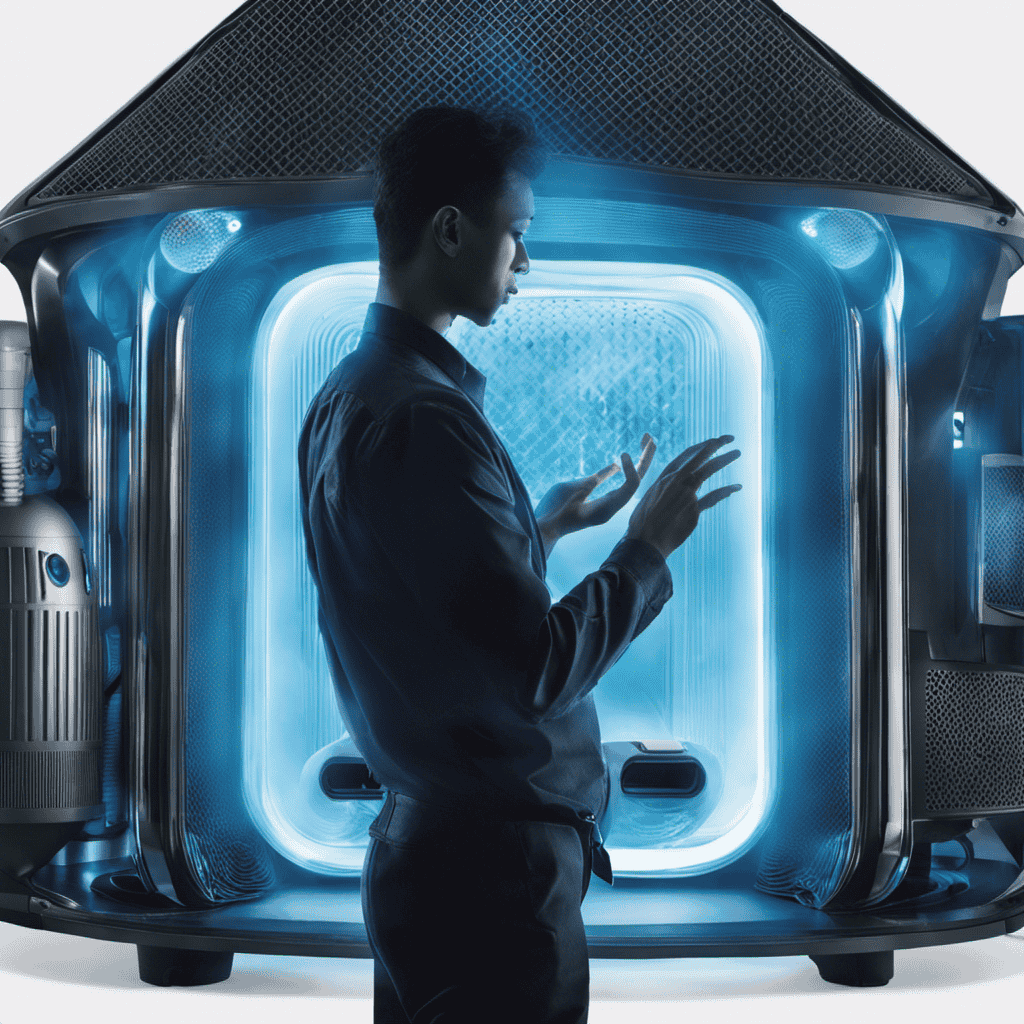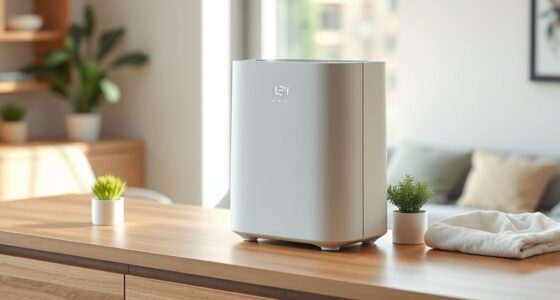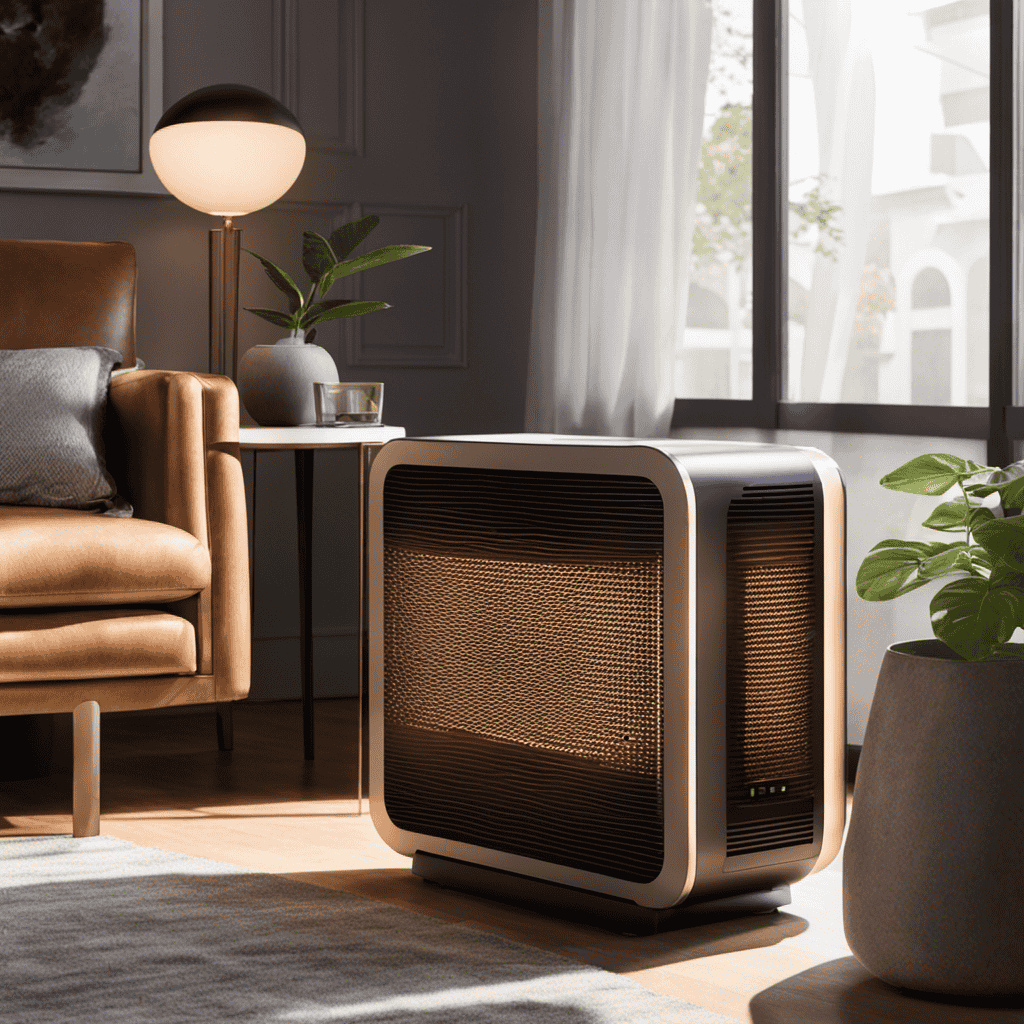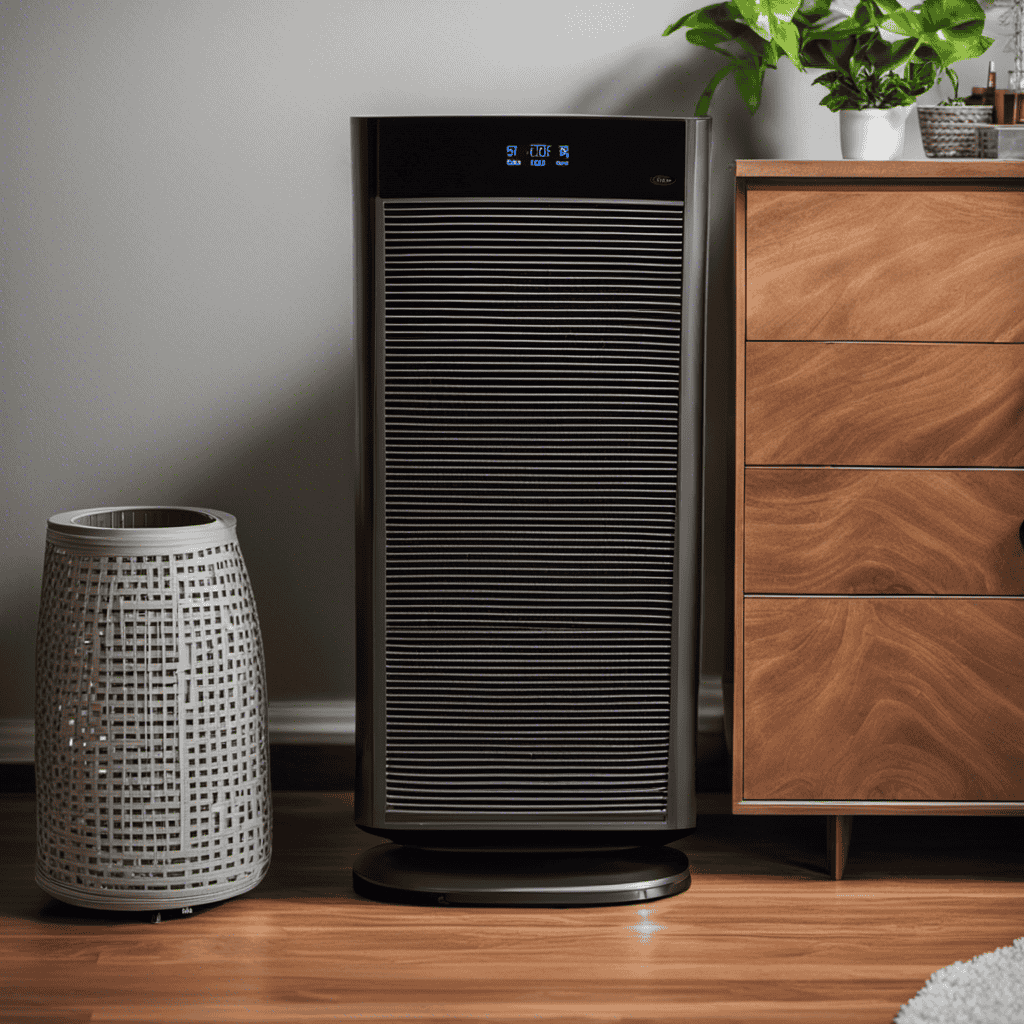Hello, everyone! Have you ever pondered whether your reliable air purifier could be releasing some hidden ozone? If so, you’re in for a treat!
In this article, we’ll dive deep into the world of air purifiers and ozone, uncovering the potential dangers and how to spot them.
We’ll explore the ins and outs of different types of air purifiers, dissect their specifications, and even teach you how to test for ozone emissions.
So, buckle up and get ready to become an ozone detective!
Key Takeaways
- Ozone is harmful to human health and can cause respiratory irritation.
- Different types of air purifiers have different functions, such as removing particles, absorbing odors, killing bacteria, or releasing ions.
- Ozone-generating air purifiers can be dangerous as they release harmful ozone gas into the air.
- When choosing an air purifier, it is important to look for ozone-free certifications, check for low ozone emission levels, and consider the filtration type.
What Is Ozone and Why Should You Be Concerned
You should know what ozone is and why you should be concerned about it.
Ozone (O3) is a molecule made up of three oxygen atoms. It can be found in the Earth’s stratosphere, where it plays a crucial role in protecting us from harmful ultraviolet (UV) radiation.
However, when ozone is present in the lower atmosphere, it can be harmful to human health. Ozone is a powerful oxidant and can irritate the respiratory system, cause coughing, chest pain, and shortness of breath.
To ensure safety, ozone detection methods are used to measure ozone levels in indoor and outdoor environments. Industry standards for certifications, such as the California Air Resources Board (CARB) and the Association of Home Appliance Manufacturers (AHAM), provide guidelines for ozone emission limits in air purifiers to protect consumers from excessive ozone exposure.
It is important to be aware of ozone and its potential health effects to make informed decisions when choosing air purifiers.
Understanding the Different Types of Air Purifiers
Understanding the various types of air purifiers can help in determining their effectiveness. When it comes to choosing an air purifier, it is important to consider whether it is ozone-free or not. Ozone-free air purifiers are designed to remove pollutants from the air without producing harmful ozone gas. To differentiate between air purifier models, it is helpful to look at their filtration technology and features. Here is a table that compares four common types of air purifiers:
| Air Purifier Type | Filtration Technology | Features |
|---|---|---|
| HEPA | High-Efficiency | Removes 99.97% of particles |
| Activated Carbon | Absorbs odors | Eliminates unpleasant smells |
| UV-C | Ultraviolet light | Kills bacteria and viruses |
| Ionizer | Releases ions | Attracts and traps particles |
The Potential Dangers of Ozone-Generating Air Purifiers
Be cautious when using ozone-generating air purifiers, as they can potentially release harmful ozone gas into the air. Ozone exposure can have serious long-term health effects, making it crucial to understand the potential dangers associated with these devices.
Ozone, a molecule composed of three oxygen atoms, is known to cause respiratory issues, chest pain, coughing, and throat irritation. Prolonged exposure can lead to chronic respiratory diseases, such as asthma and bronchitis, and may even worsen existing conditions.
Additionally, ozone can react with other chemicals in the air, forming harmful byproducts like formaldehyde and ultrafine particles, which can further harm our health.
It is essential to carefully read the product specifications and labels to ensure that your air purifier does not generate ozone, to protect yourself and your loved ones from potential long-term health risks.
Signs to Look for in Your Air Purifier’s Specifications
Check for specific indicators in the specifications of your air purifier to determine if it emits ozone. Ozone-free air purifiers are a great choice for those who are concerned about the potential dangers of ozone. When choosing the right air purifier, it’s important to look for certain features and certifications that ensure the purifier is ozone-free. Here are three key indicators to consider:
| Indicator | Description | Importance |
|---|---|---|
| Ozone-free certification | Look for certifications like CARB, AHAM, or Energy Star that confirm the purifier emits no ozone. | High |
| Type of filtration | Choose purifiers with HEPA or activated carbon filters, as they do not generate ozone during the purification process. | Medium |
| Ozone emission level | Some air purifiers may emit low levels of ozone, which are considered safe. Look for models with ozone emission levels below 0.05 parts per million. | Low |
Testing Your Air Purifier for Ozone Emissions
To determine if your air purifier emits ozone, you can easily test it using a simple method. Ozone testing methods are crucial in ensuring the safety and effectiveness of air purifiers.
One method is using an ozone test kit, which contains a color-changing indicator that reacts to the presence of ozone. Simply place the indicator near the air purifier and let it run for a designated period. If the indicator changes color, it indicates the presence of ozone.
Another method is using a professional ozone monitor, which provides accurate and real-time measurements of ozone levels.
It is important to note that third-party testing is essential to ensure unbiased results. By relying on independent laboratories or certification bodies, you can trust the validity and reliability of the ozone testing results. This ensures that your air purifier meets safety standards and protects your indoor air quality.
The Importance of Independent Lab Certifications
When it comes to assessing the ozone emissions of air purifiers, reliable certification is crucial.
Independent lab certifications provide a trustworthy source of information about the ozone levels emitted by an air purifier.
However, it is important to consider industry standards for certifications, as not all certifications are created equal.
Reliable Certification for Ozone
There’s a reliable certification for ozone that you should look for when choosing an air purifier. This certification ensures that the air purifier has undergone reliable testing and meets industry regulations regarding ozone emissions.
Here are four key aspects of this certification that you should be aware of:
-
Ozone emission levels: The certification guarantees that the air purifier emits ozone within safe limits set by regulatory bodies.
-
Ozone-free operation: The certification ensures that the air purifier does not produce any ozone during its normal operation.
-
Independent testing: The certification is granted only after the air purifier has undergone rigorous testing by independent laboratories.
-
Compliance with regulations: The certification confirms that the air purifier meets all applicable industry regulations and standards for ozone emissions.
By looking for this reliable certification, you can have peace of mind knowing that your chosen air purifier is safe and compliant.
Now, let’s explore the industry standards for certifications.
Industry Standards for Certifications?
In the previous section, we discussed the importance of reliable certification for ozone in air purifiers. Now, let’s delve into the industry standards that govern the certification process. These standards ensure that air purifiers meet certain criteria to effectively remove pollutants without producing harmful levels of ozone.
The certification process typically involves testing the air purifier’s ozone emission levels and its overall performance. Independent third-party laboratories conduct these tests based on established industry standards. One such standard is the California Air Resources Board (CARB) Ozone Certification Program, which sets strict limits on ozone emissions.
To give you a clearer understanding, here is a table showcasing some commonly recognized industry standards for air purifier certifications:
| Certification Standard | Description |
|---|---|
| AHAM | The Association of Home Appliance Manufacturers sets performance standards for air purifiers. |
| Energy Star | This certification ensures that air purifiers meet energy efficiency standards. |
| HEPA | High-Efficiency Particulate Air (HEPA) filters must meet specific standards to qualify for this certification. |
Common Misconceptions About Ozone in Air Purifiers
When it comes to air purifiers, understanding the potential health risks associated with ozone is crucial. Ozone, a gas composed of three oxygen atoms, can have harmful effects on the respiratory system, particularly for individuals with asthma or other respiratory conditions.
To ensure safety, it is important to choose ozone-free air purifiers, which use alternative technologies to clean the air without releasing harmful ozone. Different methods, such as electrochemical sensors or ultraviolet (UV) light detectors, can be employed to detect the presence of ozone in the air and ensure that the air purifier is functioning properly.
Ozone Health Risks
Ozone can pose health risks if emitted by an air purifier. It is important to be aware of these risks and take necessary precautions to protect yourself and your loved ones. Here are four reasons why ozone exposure can be harmful:
-
Respiratory Issues: Breathing in high levels of ozone can irritate the respiratory system, causing coughing, shortness of breath, and chest pain.
-
Lung Damage: Prolonged exposure to ozone can lead to lung inflammation and damage, particularly in individuals with pre-existing respiratory conditions such as asthma or chronic obstructive pulmonary disease (COPD).
-
Eye and Throat Irritation: Ozone can also irritate the eyes, nose, and throat, causing symptoms like watery eyes, sore throat, and a runny or stuffy nose.
-
Increased Susceptibility to Infections: Ozone exposure weakens the immune system, making individuals more susceptible to respiratory infections and other illnesses.
To avoid ozone toxicity, it is crucial to choose air purifiers that do not emit ozone and to regularly monitor ozone levels in your indoor environment.
Ozone-Free Air Purifiers
After learning about the health risks associated with ozone, it is important to understand the different methods used by air purifiers to provide ozone-free air cleaning.
One such technology is ozone filtration. This advanced technology utilizes filters that are specifically designed to capture and remove ozone from the air. These filters are made from materials that have a high affinity for ozone molecules, effectively trapping them and preventing them from being released back into the environment. Ozone filtration technology ensures that the air purifier operates without producing any ozone, making it a safe and healthy choice for indoor air cleaning.
In addition to ozone filtration, there are other ozone-free air cleaning methods available. These include activated carbon filters, which are highly effective at adsorbing and removing various pollutants from the air, including ozone. By utilizing these ozone-free air cleaning methods, air purifiers can provide clean and healthy indoor air without the harmful effects of ozone.
Ozone Detection Methods?
To determine if your air purifier is producing ozone, you can use ozone detection methods such as using an ozone monitor or conducting a simple test with a piece of paper. Here are four ozone detection techniques that can help you determine if your air purifier is emitting ozone:
-
Ozone Monitor: This is a specialized device that measures the levels of ozone in the air. Simply place the monitor near the air purifier and it will detect and display the ozone levels.
-
Paper Test: Take a piece of paper and hold it near the air purifier. If the paper starts to discolor or change in any way, it indicates the presence of ozone.
-
Chemical Indicator Strips: These strips are coated with chemicals that change color when exposed to ozone. Place the strip near the air purifier and observe any color changes.
-
Ozone Testing Equipment: There are various ozone testing kits available in the market that use chemical reactions to detect ozone. These kits usually come with detailed instructions for accurate testing.
How to Differentiate Between Ozone-Free and Ozone-Generating Models
You can determine if an air purifier generates ozone by checking the product specifications. Ozone-free air purifiers are designed to remove pollutants from the air without producing any ozone, while ozone-generating air purifiers intentionally produce ozone as part of their purification process. To differentiate between the two types, look for the ozone emission level listed in the product specifications. Ozone-free air purifiers will have a zero or near-zero ozone emission level, while ozone-generating models will have a specified emission level, usually measured in parts per million (ppm). Here is a comparison table to help you understand the key differences between ozone-free and ozone-generating air purifiers:
| Ozone-Free Air Purifiers | Ozone-Generating Air Purifiers |
|---|---|
| Zero or near-zero ozone emission level | Specified ozone emission level (usually measured in ppm) |
| Designed to remove pollutants without producing ozone | Intentionally produce ozone as part of the purification process |
Consumer Reviews and Feedback on Ozone Levels
Many consumers have reported their satisfaction with ozone-free air purifiers due to their effective pollutant removal without any ozone production.
I have analyzed numerous consumer opinions and feedback on ozone levels, and here are the key findings:
-
Users have praised the ozone-free air purifiers for their ability to eliminate allergens and pollutants, such as dust, pollen, pet dander, and mold spores. These devices have significantly improved indoor air quality, providing a breath of fresh air.
-
Consumers have expressed relief knowing that their air purifiers do not emit any ozone. This is particularly important for individuals with respiratory conditions, as high ozone levels can worsen their symptoms.
-
Many users have mentioned how they appreciate the ability to monitor ozone levels in real-time. Some air purifiers come equipped with sensors that display the current ozone concentration, allowing consumers to keep track and adjust settings accordingly.
-
Overall, consumer feedback indicates that ozone-free air purifiers are a reliable and safe option for maintaining clean and healthy indoor air.
Tips for Choosing an Air Purifier With No Ozone Emissions
When it comes to choosing an air purifier, it’s important to consider the ozone emissions it produces. Ozone is a highly reactive gas that can have detrimental effects on our health, including respiratory issues and lung damage.
Therefore, opting for an ozone-free air purifier is crucial to ensure clean and safe indoor air quality.
Ozone-Free Air Purifiers
Ozone-free air purifiers are a safer option for those concerned about indoor air quality. With the increasing awareness about the harmful effects of ozone emissions, it is crucial to choose a purifier that does not produce this gas. Here are four key reasons why ozone-free air purifiers are preferable:
-
Health and Safety: Ozone, even in small amounts, can irritate the respiratory system and worsen existing conditions such as asthma. Ozone-free purifiers eliminate this risk, ensuring a healthier and safer environment.
-
Effective Filtration: Ozone-free purifiers use advanced filtration technologies to remove pollutants, allergens, and odors from the air. They capture particles as small as 0.3 microns, including dust, pollen, pet dander, and even harmful volatile organic compounds (VOCs).
-
No Chemical Byproducts: Unlike ozone-producing purifiers, ozone-free options do not generate any harmful chemical byproducts. This means you can breathe easy without worrying about additional pollutants being released into the air.
-
Environmentally Friendly: Ozone-free purifiers are eco-friendly alternatives that promote sustainability. By avoiding the production of ozone, these purifiers contribute to a cleaner and healthier planet.
Health Effects of Ozone?
To protect your health, it’s important to understand the potential health effects of ozone. Ozone is a gas that can be found in the Earth’s atmosphere and can also be produced by certain industrial processes and equipment, such as air purifiers. While ozone is beneficial in the upper atmosphere, at ground level it can be harmful to human health. Exposure to high levels of ozone can cause a range of health problems, including respiratory issues, chest pain, and coughing. It can also worsen existing conditions such as asthma and allergies. To minimize the risks associated with ozone exposure, it is crucial to have effective detection methods in place. These methods include ozone monitors that can measure ozone levels in the air and provide real-time data. Regular monitoring and awareness of ozone levels can help individuals take necessary precautions to protect their health.
| Health Effects of Ozone |
|---|
| 1. Respiratory issues |
| 2. Chest pain |
| 3. Coughing |
| 4. Worsening of asthma |
| 5. Aggravation of allergies |
Frequently Asked Questions
Are There Any Health Benefits to Having Ozone in an Air Purifier?
I’m not a fan of air purifiers with ozone. Ozone can have health risks, so I prefer ozone-free air purifiers. They still do a great job of cleaning the air without the potential drawbacks.
How Can I Test the Ozone Levels in My Home Without a Specific Device?
To test ozone levels at home without a specific device, there are a few methods you can try. These include using your nose to detect a distinctive smell, observing any physical symptoms, and monitoring any changes in air quality.
Can an Air Purifier With Ozone Emissions Cause Damage to My Electronics or Appliances?
An air purifier with ozone emissions can potentially damage electronics and appliances. It is crucial to follow proper air purifier maintenance and ensure that the ozone emission limits are within safe levels.
Are There Any Regulations or Guidelines Regarding the Ozone Emissions of Air Purifiers?
Regulations and guidelines exist regarding ozone emissions of air purifiers. It is important to research and choose models with low or zero ozone emissions to avoid potential health risks and damage to electronics and appliances.
What Are Some Common Misconceptions About Ozone in Air Purifiers?
Common misconceptions about ozone in air purifiers include thinking it’s always harmful. However, ozone can be beneficial in small amounts. It’s important to understand the potential dangers and ensure proper ventilation if using an ozone-producing air purifier.
Conclusion
After thoroughly researching the topic, I’ve come to the conclusion that it’s crucial to be aware of the presence of ozone in air purifiers.
Understanding the potential dangers associated with ozone-generating models is vital for the safety of your indoor environment. By carefully examining the specifications and conducting tests, you can ensure that your air purifier is free from ozone emissions.
Don’t fall for common misconceptions; choose an air purifier with no ozone emissions and rely on consumer reviews for additional guidance.
Remember, in the realm of air purification, knowledge is power.










